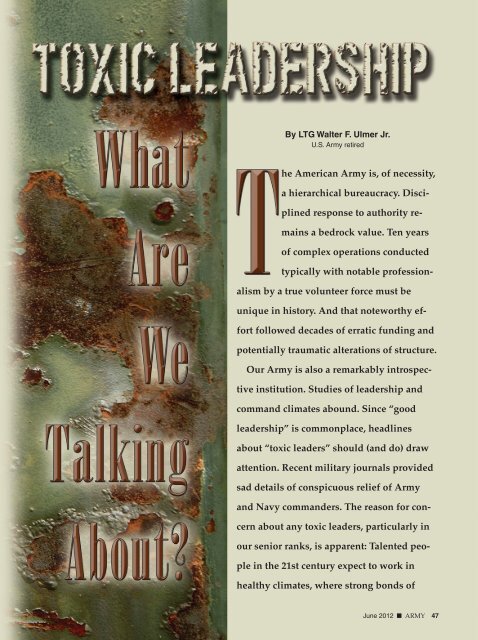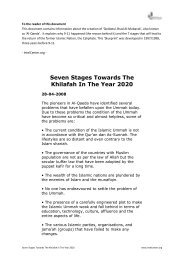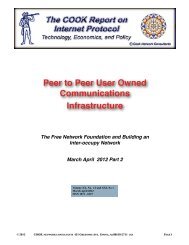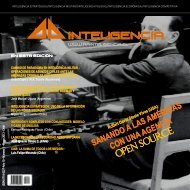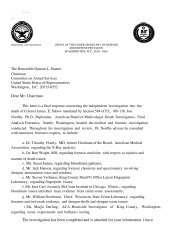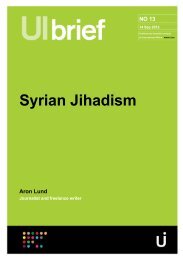Toxic Leadership: What Are We Talking About? - Association of the ...
Toxic Leadership: What Are We Talking About? - Association of the ...
Toxic Leadership: What Are We Talking About? - Association of the ...
You also want an ePaper? Increase the reach of your titles
YUMPU automatically turns print PDFs into web optimized ePapers that Google loves.
By LTG Walter F. Ulmer Jr.<br />
U.S. Army retired<br />
he American Army is, <strong>of</strong> necessity,<br />
a hierarchical bureaucracy. Disciplined<br />
response to authority remains<br />
a bedrock value. Ten years<br />
<strong>of</strong> complex operations conducted<br />
typically with notable pr<strong>of</strong>essionalism<br />
by a true volunteer force must be<br />
unique in history. And that noteworthy ef -<br />
fort followed decades <strong>of</strong> erratic funding and<br />
potentially traumatic alterations <strong>of</strong> structure.<br />
Our Army is also a remarkably introspective<br />
institution. Studies <strong>of</strong> leadership and<br />
command climates abound. Since “good<br />
leadership” is commonplace, headlines<br />
about “toxic leaders” should (and do) draw<br />
attention. Recent military journals provided<br />
sad details <strong>of</strong> conspicuous relief <strong>of</strong> Army<br />
and Navy commanders. The reason for concern<br />
about any toxic leaders, particularly in<br />
our senior ranks, is apparent: Talented people<br />
in <strong>the</strong> 21st century expect to work in<br />
healthy climates, where strong bonds <strong>of</strong><br />
June 2012 ■ ARMY 47
mutual trust facilitate mission accomplishment and support<br />
long-term institutional strength. <strong>Toxic</strong> leaders corrupt<br />
healthy climates. Indeed, <strong>the</strong>ir very presence, even in small<br />
numbers, undermines confidence in <strong>the</strong> institution’s commitment<br />
to high standards <strong>of</strong> leadership.<br />
Defining ‘<strong>Toxic</strong> Leader’<br />
Defining toxic leader is <strong>the</strong> first priority before addressing<br />
numbers, impact, cause and solution. <strong>We</strong>bster’s defines<br />
toxic as poisonous, not far from destructive or harmful. Naturally,<br />
<strong>the</strong> definition varies with <strong>the</strong> culture: Some routine<br />
styles <strong>of</strong> command aboard <strong>the</strong> HMS Bounty would not be<br />
tolerated today. Soldiers today have suitably high expectations<br />
about <strong>the</strong> kind <strong>of</strong> leader behavior we have identified<br />
as doctrine.<br />
In response to a Secretary <strong>of</strong> <strong>the</strong> Army tasking in 2003,<br />
U.S. Army War College faculty and students stated that<br />
toxic leaders “are focused on visible short-term mission accomplishment<br />
… provide superiors with impressive, articulate<br />
presentations and enthusiastic responses to missions<br />
… [but] are unconcerned about, or oblivious to, staff or<br />
troop morale and/or climate … [and] are seen by <strong>the</strong> majority<br />
<strong>of</strong> subordinates as arrogant, self-serving, inflexible,<br />
and petty.” This definition reminds us that not all elements<br />
<strong>of</strong> a toxic personality are independently destructive. <strong>We</strong><br />
prize “articulate presentations and enthusiastic responses<br />
to missions.” The phrase in <strong>the</strong> 2003 definition, “are seen<br />
by <strong>the</strong> majority <strong>of</strong> subordinates,” is significant. In determining<br />
leader toxicity, group consensus is powerful.<br />
The U.S. Army War College study, “<strong>Leadership</strong> Lessons<br />
at Division Command Level-2010: A Review <strong>of</strong> Division<br />
Commander Leader Behaviors and Organizational Climates<br />
in Selected Army Divisions after Nine Years <strong>of</strong> War,”<br />
surveyed and interviewed 183 <strong>of</strong>ficers from four divisions<br />
just returning from deployment in Operation Iraqi Freedom<br />
or Operation Enduring Freedom. The study summarized<br />
<strong>of</strong>ficer views <strong>of</strong> toxic leaders as “self-serving, arrogant,<br />
volatile, and opinionated to <strong>the</strong> point <strong>of</strong> being<br />
organizationally dysfunctional … very persuasive, responsive,<br />
and accommodating to <strong>the</strong>ir seniors.” In those interviews,<br />
<strong>the</strong> report continued, “it seemed clear that <strong>of</strong>ficers<br />
were not describing <strong>the</strong> ‘tough but fair,’ or even <strong>the</strong> ‘oversupervisor,’<br />
or <strong>the</strong> ‘not really good with people,’ or even<br />
<strong>the</strong> ‘rarely takes tactical initiative.’” These <strong>of</strong>ficers’ perceptions<br />
make a discernible, important distinction between<br />
tough and toxic. An assessment <strong>of</strong> a leader as inferior or<br />
LTG Walter F. Ulmer Jr., USA Ret., commanded <strong>the</strong> 3rd Armored<br />
Division and III Corps, was director <strong>of</strong> human resources<br />
development at HQDA, and served as Commandant<br />
<strong>of</strong> Cadets at USMA. He served as president and CEO <strong>of</strong> <strong>the</strong><br />
Center for Creative <strong>Leadership</strong> and is co-author <strong>of</strong> several<br />
studies <strong>of</strong> <strong>of</strong>ficer leadership including <strong>the</strong> U.S. Army War College<br />
1970 “Study on Military Pr<strong>of</strong>essionalism;” <strong>the</strong> 2000<br />
CSIS study, “American Military Culture in <strong>the</strong> Twenty-first<br />
Century;”and <strong>the</strong> 2004 and 2010 studies, “<strong>Leadership</strong> Lessons<br />
at Division Command Level.”<br />
even unsatisfactory based on decision-making inadequacies,<br />
clumsy interpersonal skills or lack <strong>of</strong> drive did not automatically<br />
label him as toxic. It is also possible to “make<br />
tough, sound decisions on time,” “see <strong>the</strong> big picture [and]<br />
provide context and perspective,” and “get out <strong>of</strong> <strong>the</strong><br />
headquarters and visit <strong>the</strong> troops”—<strong>the</strong> top behaviors <strong>of</strong> a<br />
highly regarded senior leader as reported in a 2004 division<br />
commander study—and still be conspicuously toxic<br />
as judged by a majority <strong>of</strong> subordinates. In o<strong>the</strong>r words,<br />
while all toxic <strong>of</strong>ficers are ultimately poor leaders, not all<br />
poor leaders are toxic. The forthcoming version <strong>of</strong> Army<br />
Doctrine Publication 6-22, Army <strong>Leadership</strong> notes, “<strong>Toxic</strong><br />
leadership is a combination <strong>of</strong> self-centered attitudes, motivations<br />
and behaviors that have adverse effects on subordinates,<br />
<strong>the</strong> organization and mission performance.” A recent<br />
study on ethical behavior by <strong>the</strong> Army Center <strong>of</strong><br />
Excellence for <strong>the</strong> Pr<strong>of</strong>essional Military Ethic, “ACPME<br />
Technical Report 2010-01: MNF-I Excellence in Character<br />
and Ethical <strong>Leadership</strong> (EXCEL) Study,” stated, “The<br />
Army should develop leaders who understand <strong>the</strong> line between<br />
being firm … and being abusive; and identify and<br />
separate those found to be abusive.” Identify and separate<br />
are <strong>the</strong> important words.<br />
A proposed definition: <strong>Toxic</strong> leaders are individuals<br />
whose behavior appears driven by self-centered careerism<br />
at <strong>the</strong> expense <strong>of</strong> <strong>the</strong>ir subordinates and unit, and whose<br />
style is characterized by abusive and dictatorial behavior<br />
that promotes an unhealthy organizational climate. O<strong>the</strong>r<br />
observations about toxic leaders from surveys, interviews<br />
and literature—most derived from research and discussions<br />
about senior leaders or managers—are:<br />
■ They rarely take blame or share glory.<br />
■ They are not toxic all <strong>the</strong> time, or to all people.<br />
■ They are rarely if ever toxic when in <strong>the</strong> company <strong>of</strong><br />
“<strong>the</strong> boss.”<br />
■ They sometimes have good ideas and accomplish<br />
good things.<br />
■ They can be charming when <strong>the</strong> occasion fits.<br />
■ They are frequently described as extremely bright and<br />
hard-working.<br />
■ They <strong>of</strong>ten have a coterie <strong>of</strong> devoted “fans” who keep<br />
appearing on <strong>the</strong>ir staffs.<br />
■ Most have been seen as toxic by subordinates since<br />
early in <strong>the</strong>ir career.<br />
■ Their boss ei<strong>the</strong>r does not know or pretends not to know,<br />
and almost never records, <strong>the</strong>ir abuse <strong>of</strong> subordinates.<br />
Numbers <strong>of</strong> <strong>Toxic</strong> Leaders<br />
Because <strong>the</strong>re is no standard definition <strong>of</strong> toxic, because<br />
perceptions about a superior’s behavior are subjective, because<br />
our Army culture puts loyalty to <strong>the</strong> leader and ability<br />
to absorb hardship <strong>of</strong> all kinds high on <strong>the</strong> attribute list,<br />
and because a degree <strong>of</strong> harshness has characterized some<br />
highly regarded <strong>of</strong>ficers, estimates <strong>of</strong> <strong>the</strong> numbers <strong>of</strong> toxic<br />
leaders are just that—estimates. The data become less subjective,<br />
however, when we can assess also <strong>the</strong> impact <strong>of</strong><br />
toxic leadership on <strong>the</strong> climate <strong>of</strong> <strong>the</strong> organization.<br />
48 ARMY ■ June 2012
The best current reference on <strong>the</strong> toxic leader issue is <strong>the</strong><br />
Center for Army <strong>Leadership</strong> (CAL) “Technical Report 2011-<br />
3,” which garnered some national press recently. Estimates<br />
<strong>of</strong> toxic leaders in that study, which assessed both noncommissioned<br />
and commissioned <strong>of</strong>ficers, ranged into <strong>the</strong> 20<br />
percent level. That very high number might have resulted<br />
in part from a broad interpretation by respondents <strong>of</strong> a<br />
toxic leader, although study members took efforts to ensure<br />
that toxicity was differentiated from simply poor leadership.<br />
A recent survey at <strong>the</strong> U.S. Army Command and General<br />
Staff College, however, found a figure <strong>of</strong> nearly 18 percent.<br />
<strong>What</strong>ever <strong>the</strong> numbers are today, <strong>the</strong> sense <strong>of</strong> <strong>the</strong><br />
<strong>of</strong>ficer corps is that <strong>the</strong>re are undoubtedly toxic leaders<br />
among us with <strong>the</strong> possibility that <strong>the</strong>ir numbers are decreasing<br />
somewhat from some undetermined past date.<br />
One slice <strong>of</strong> information on percentages <strong>of</strong> perceived<br />
toxic leaders among colonels and general <strong>of</strong>ficers—<strong>the</strong><br />
level constituting <strong>the</strong> greatest potential danger to operational<br />
effectiveness and retention <strong>of</strong> high-quality people—<br />
comes from informal surveys <strong>of</strong> some students at <strong>the</strong> Command<br />
and General Staff College (CGSC) and <strong>the</strong> Army<br />
War College over a period <strong>of</strong> 15 years. (See <strong>the</strong> chart on <strong>the</strong><br />
next page.) These data describing colonels and generals are<br />
derived from inputs from successful student <strong>of</strong>ficers who<br />
had been treated well by <strong>the</strong> institution.<br />
The percentages <strong>of</strong> senior leaders perceived by <strong>the</strong>ir subordinates<br />
to be outstanding/transformational (30–50 percent)<br />
would be viewed as remarkably high in any organization.<br />
Those figures are a tribute to persistent Army<br />
efforts to develop and select good leaders. The “toxic”<br />
numbers, however, are also remarkable. They deserve an<br />
institutional response. A mission command culture could<br />
be strangled by this percentage <strong>of</strong> toxic senior leaders in<br />
<strong>the</strong> force. A very good soldier and scientist, LTC Larry Ingraham,<br />
now deceased, commented on <strong>the</strong> dramatic differences<br />
among subordinate reputations <strong>of</strong> senior <strong>of</strong>ficers,<br />
saying that <strong>the</strong> personnel system that cannot distinguish<br />
between <strong>the</strong> revered and <strong>the</strong> despised must have a fundamental<br />
flaw.<br />
Why <strong>Toxic</strong> Leaders Survive in Our Culture<br />
Military environments are fertile ground for both growing<br />
outstanding leaders and tolerating tyrants. As a culture<br />
we value cooperation, loyalty and respect for authority. <strong>We</strong><br />
honor a “can-do” attitude. <strong>We</strong> build unit pride and are uncomfortable<br />
with malcontents. <strong>We</strong> rightly prize mission accomplishment.<br />
As long as <strong>the</strong> mission is relatively shortterm,<br />
before a destructive climate raises its ugly head, <strong>the</strong><br />
toxic can-do personality can prosper. Subordinates are reluctant<br />
to identify <strong>the</strong>ir boss as toxic. They feel a loyalty<br />
and do not want to embarrass <strong>the</strong>ir unit. They want to<br />
“survive” <strong>the</strong>mselves and not be written <strong>of</strong>f as troublemakers.<br />
In addition, it takes a very strong and perceptive<br />
boss to identify a subordinate as toxic and take action.<br />
Most actions to relieve a toxic leader were set in motion<br />
only after a public spectacle forced an investigation that<br />
uncovered toxic leadership as a root cause.<br />
Considerable work has been done in <strong>the</strong> social, behavioral<br />
and cognitive sciences on toxic or destructive leaders.<br />
An article in <strong>the</strong> June 2007 issue <strong>of</strong> The <strong>Leadership</strong> Quarterly,<br />
“The <strong>Toxic</strong> Triangle: Destructive Leaders, Susceptible Followers,<br />
and Conducive Environments,” provides an excellent<br />
summary, stating, “Three components <strong>of</strong> charisma apply<br />
to destructive leaders: vision, self-presentational skills,<br />
and personal energy.” It is interesting to see how closely<br />
<strong>the</strong>se descriptions apply to current Army <strong>of</strong>ficers. The referenced<br />
paper explains <strong>the</strong> role <strong>of</strong> <strong>the</strong> narcissistic personality<br />
whose “sense <strong>of</strong> entitlement <strong>of</strong>ten leads to self-serving<br />
abuses <strong>of</strong> power.” The fact that toxic behavior is typically<br />
linked to a substantially compromised personality does<br />
not augur well for on-<strong>the</strong>-job remediation or development<br />
as an institutional solution.<br />
Although alerted for years to <strong>the</strong> issue, as an institution<br />
we have been reluctant to confront it directly. <strong>We</strong> have put<br />
faith in incremental adjustments to education, training and<br />
development systems. There has been little urgency to act<br />
systematically. The rarely conspicuous cases were handled<br />
individually with apparently rare exploration <strong>of</strong> underlying<br />
cultural issues. This was partly because our institution<br />
has performed well overall, because <strong>of</strong> our <strong>of</strong>ten “if it ain’t<br />
broke don’t fix it” mentality, and because <strong>the</strong> senior leader<br />
time and energy needed to fix complex internal systems<br />
were understandably captured by immediate crises that<br />
demanded <strong>the</strong>ir attention. Our institution is by no means<br />
broken, but it deserves some refurbishing.<br />
There are lingering doubts within <strong>the</strong> Army about implementing<br />
remedial programs that would give subordinates<br />
any formal voice in <strong>the</strong> personnel management<br />
process. The predominant fear is <strong>of</strong> an eventual weakening<br />
<strong>of</strong> <strong>the</strong> chain <strong>of</strong> command. There are understandable suspicions<br />
also that many reports <strong>of</strong> toxic leadership are from<br />
dissatisfied subordinates who failed to meet <strong>the</strong> legitimate<br />
expectations <strong>of</strong> demanding bosses. That contention is not<br />
supported by recent studies but could provide a rationale<br />
for avoiding <strong>the</strong> unpleasant business <strong>of</strong> digging into complex<br />
personnel systems. The toxic leader phenomenon is a<br />
slowly growing organizational cancer that can be tolerated<br />
by resilient people for a long time before causing sharp institutional<br />
pain.<br />
Solution Concepts<br />
<strong>We</strong> are correctly cautious in adopting practices that have<br />
even a remote possibility <strong>of</strong> compromising command authority.<br />
Even admitting <strong>the</strong>re are toxic leaders in our midst<br />
is problematic for a few <strong>of</strong>ficers. For <strong>the</strong> vast majority <strong>of</strong> <strong>of</strong>ficers<br />
a pretension that <strong>the</strong>re are none seems patently dishonest.<br />
In any case, staying on <strong>the</strong> current path has no rational<br />
hope for solving <strong>the</strong> problem. Meanwhile, tolerance<br />
for toxic leaders among current members <strong>of</strong> <strong>the</strong> force is<br />
conspicuously low. Perceived institutional nonchalance<br />
about <strong>the</strong> situation is a serious contradiction <strong>of</strong> espoused<br />
Army values. The desired mission command culture depends<br />
heavily on an environment <strong>of</strong> mutual trust that only<br />
high-quality leaders can produce.<br />
50 ARMY ■ June 2012
Two <strong>of</strong> <strong>the</strong> categories used in data collected from selected CGSC and War College<br />
student samples during 1996–2010<br />
Estimates in population<br />
Essentially transformational: Inspirational, encouraging, puts mission and troops<br />
first; coaches, builds teams and a healthy climate; sets high standards for self and<br />
o<strong>the</strong>rs; generates and reciprocates trust.<br />
30–50 percent<br />
Essentially toxic: Alienates and abuses subordinates; creates a hostile climate; <strong>of</strong>ten<br />
rules by fear; rejects bad news; seen as self-serving and arrogant; is skillful in upward<br />
relationships; usually bright, energetic and technically competent.<br />
8–10 percent<br />
Various ongoing initiatives must be integrated into a<br />
comprehensive program in which education <strong>of</strong> <strong>the</strong> <strong>of</strong>ficer<br />
corps on objectives, concepts and details <strong>of</strong> <strong>the</strong>se initiatives<br />
would play a major role. As <strong>the</strong> CAL 2011 report states,<br />
“This problem must be attacked simultaneously at several<br />
levels.” A near-term goal is precluding toxic leaders from<br />
getting into <strong>the</strong> pool <strong>of</strong> colonels who are general <strong>of</strong>ficer<br />
candidates—a practice that if carefully explained and fairly<br />
implemented could by itself rejuvenate faith in Army promotion<br />
and selection systems and reinforce important<br />
Army values by practicing what we preach. Such initiatives<br />
include <strong>the</strong> following.<br />
Institute a system for regularly reporting <strong>the</strong> results <strong>of</strong> command<br />
climate surveys. This effort should parallel systems for<br />
reporting o<strong>the</strong>r elements <strong>of</strong> <strong>the</strong> readiness system, with<br />
Army-wide collection <strong>of</strong> periodic data. Battalion-size units<br />
and staffs at division level and higher should be <strong>the</strong> primary<br />
targets for standardized climate assessments.<br />
Climate assessments have been around longer than <strong>the</strong><br />
360 process and remain an important tool for commanders.<br />
They have never been collected Army-wide with <strong>the</strong> same<br />
comprehensive regularity as materiel and training readiness<br />
reports, although we emphasize that troop morale is a<br />
vital ingredient in combat power.<br />
Climate surveys can be designed for user convenience,<br />
are a method <strong>of</strong> reinforcing Army values and can provide<br />
advance warning <strong>of</strong> toxic leadership. (Determination <strong>of</strong><br />
who has access to climate data and <strong>the</strong> levels <strong>of</strong> consolidation<br />
and review <strong>of</strong> reports are issues requiring careful attention.)<br />
Provide selection boards with supplemental information from<br />
subordinates. This will enhance <strong>the</strong> validity <strong>of</strong> <strong>the</strong> top-down<br />
information now available and is <strong>the</strong> heart <strong>of</strong> any serious<br />
attempt to rid <strong>the</strong> institution <strong>of</strong> <strong>the</strong> toxic leader. Exclusively<br />
top-down assessments have failed to eliminate toxic<br />
leaders from hierarchical organizations, even those with<br />
generally solid reputations such as <strong>the</strong> U.S. Army.<br />
The 2010 Division Commander Study recommends: “Revise<br />
significantly <strong>the</strong> process for selection to O-6 command<br />
to ensure that <strong>the</strong>re are no future candidates for Division<br />
Command who have been identified clearly as toxic leaders.<br />
Specifically, provide boards selecting brigade-level<br />
commanders with supplemental data summarizing leadership<br />
behavior assessments taken from a sample <strong>of</strong> <strong>of</strong>ficers<br />
who had served as company commanders or principal<br />
staff <strong>of</strong>fices when <strong>the</strong> individuals being considered were<br />
<strong>the</strong>ir battalion commanders.” The description <strong>of</strong> a proposed<br />
pilot study <strong>of</strong> this procedure explains that <strong>the</strong> assessments<br />
<strong>of</strong> subordinates are taken usually one to three<br />
years after <strong>the</strong> candidate for O-6 command has departed<br />
<strong>the</strong> previous battalion-level command. (This is not use <strong>of</strong> a<br />
360 “feedback” process. That process, designed for enhanced<br />
self-awareness and continuing growth as a leader,<br />
is used only for that purpose. It must be maintained absolutely<br />
separate from any subordinate input designed<br />
and denoted as part <strong>of</strong> <strong>the</strong> promotion, selection or assignment<br />
process.)<br />
Given <strong>the</strong> limitations <strong>of</strong> <strong>the</strong> current database on <strong>of</strong>ficer<br />
performance, <strong>the</strong>re may not be opportunities for <strong>the</strong> personnel<br />
management process to reliably and systematically<br />
identify <strong>the</strong> toxic leader earlier than selection for O-6 assignments.<br />
A carefully designed and closely monitored pilot<br />
program (over several years), however, may uncover<br />
possibilities for earlier intervention and would in itself indicate<br />
<strong>the</strong> Army’s commitment to confront <strong>the</strong> problem.<br />
Establish a general <strong>of</strong>ficer steering committee. This will report<br />
to <strong>the</strong> Chief <strong>of</strong> Staff, perhaps led by <strong>the</strong> commanding<br />
general <strong>of</strong> U.S. Army Training and Doctrine Command, to<br />
coordinate, guide and oversee <strong>the</strong> implementation <strong>of</strong> systems<br />
modifications and innovations necessary to address<br />
comprehensively <strong>the</strong> toxic leader issue while simultaneously<br />
enhancing <strong>the</strong> quality <strong>of</strong> command climates.<br />
Do not spend additional resources on fur<strong>the</strong>r external studies.<br />
All <strong>the</strong> necessary experience and expertise are available<br />
within Army agencies. The key is to coordinate and integrate<br />
ongoing efforts into a comprehensive program in<br />
which education <strong>of</strong> <strong>the</strong> <strong>of</strong>ficer corps on <strong>the</strong> toxic leader issue<br />
should play a conspicuous role.<br />
In light <strong>of</strong> <strong>the</strong> current commitment and attention <strong>of</strong><br />
Army senior leaders, <strong>the</strong> urgency <strong>of</strong> creating supportive<br />
climates that will motivate and retain high-quality people,<br />
and <strong>the</strong> recognition that viable solutions for solving <strong>the</strong><br />
problem and streng<strong>the</strong>ning <strong>the</strong> institution are at hand, <strong>the</strong><br />
time seems ripe for action.<br />
✭<br />
52 ARMY ■ June 2012


